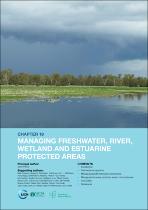JavaScript is disabled for your browser. Some features of this site may not work without it.
- ResearchSpace
- →
- Research Publications/Outputs
- →
- Book Chapters
- →
- View Item
| dc.contributor.author |
Pittock, J

|
|
| dc.contributor.author |
Finlayson, M

|
|
| dc.contributor.author |
Arthington, AH

|
|
| dc.contributor.author |
Roux, D

|
|
| dc.contributor.author |
Matthews, JH

|
|
| dc.contributor.author |
Biggs, H

|
|
| dc.contributor.author |
Harrison, I

|
|
| dc.contributor.author |
Blom, E

|
|
| dc.contributor.author |
Flitcroft, R

|
|
| dc.contributor.author |
Froend, R

|
|
| dc.contributor.author |
Nunes da Cunha, C

|
|
| dc.contributor.author |
Van Niekerk, Lara

|
|
| dc.date.accessioned | 2019-04-02T10:12:43Z | |
| dc.date.available | 2019-04-02T10:12:43Z | |
| dc.date.issued | 2015 | |
| dc.identifier.citation | Pittock, J. et al. 2015. Managing freshwater, river, wetland and estuarine protected areas. Protected Area Governance and Management, pp. 569-608 | en_US |
| dc.identifier.isbn | 9781925021684 | |
| dc.identifier.uri | http://press-files.anu.edu.au/downloads/press/p312491/pdf/CHAPTER19.pdf | |
| dc.identifier.uri | http://hdl.handle.net/10204/10908 | |
| dc.description | Chapter published in Protected Area Governance and Management, pp. 569-608 | en_US |
| dc.description.abstract | The authors start by defining inland aquatic ecosystems. They then examine the principles and processes that are essential to conservation of freshwater ecosystems and aquatic species. Briefly, the authors introduce the threats to freshwater ecosystems and the flow-on implications for protected area design. A number of the counterintuitive implications for and conflicts between terrestrial versus freshwater protected area design and management are then detailed. Case studies are used to illustrate principles and practices applied around the world. The next section of the chapter considers the specific management needs of rivers and swamps, lakes, peatlands, groundwater-dependent ecosystems and estuaries. Methods and options for providing environmental flows to conserve biodiversity and ecosystem services are summarised. They then turn to management of fresh waters in protected areas in the broader landscape, showing how natural resource governance processes can be harnessed to better manage freshwater biodiversity in protected areas. The final section is vital for all protected areas with freshwater components, addressing how they can adapt to climate change. | en_US |
| dc.language.iso | en | en_US |
| dc.relation.ispartofseries | Worklist;17130 | |
| dc.subject | Aquatic species | en_US |
| dc.subject | Environmental flows | en_US |
| dc.subject | Freshwater ecosystems | en_US |
| dc.subject | Managing freshwater | en_US |
| dc.subject | Wetland | en_US |
| dc.title | Managing freshwater, river, wetland and estuarine protected areas | en_US |
| dc.type | Book Chapter | en_US |
| dc.identifier.apacitation | Pittock, J., Finlayson, M., Arthington, A., Roux, D., Matthews, J., Biggs, H., ... Van Niekerk, L. (2015). Managing freshwater, river, wetland and estuarine protected areas., <i>Worklist;17130</i> http://hdl.handle.net/10204/10908 | en_ZA |
| dc.identifier.chicagocitation | Pittock, J, M Finlayson, AH Arthington, D Roux, JH Matthews, H Biggs, I Harrison, et al. "Managing freshwater, river, wetland and estuarine protected areas" In <i>WORKLIST;17130</i>, n.p.: n.p. 2015. http://hdl.handle.net/10204/10908. | en_ZA |
| dc.identifier.vancouvercitation | Pittock J, Finlayson M, Arthington A, Roux D, Matthews J, Biggs H, et al. Managing freshwater, river, wetland and estuarine protected areas.. Worklist;17130. [place unknown]: [publisher unknown]; 2015. [cited yyyy month dd]. http://hdl.handle.net/10204/10908. | en_ZA |
| dc.identifier.ris | TY - Book Chapter AU - Pittock, J AU - Finlayson, M AU - Arthington, AH AU - Roux, D AU - Matthews, JH AU - Biggs, H AU - Harrison, I AU - Blom, E AU - Flitcroft, R AU - Froend, R AU - Nunes da Cunha, C AU - Van Niekerk, Lara AB - The authors start by defining inland aquatic ecosystems. They then examine the principles and processes that are essential to conservation of freshwater ecosystems and aquatic species. Briefly, the authors introduce the threats to freshwater ecosystems and the flow-on implications for protected area design. A number of the counterintuitive implications for and conflicts between terrestrial versus freshwater protected area design and management are then detailed. Case studies are used to illustrate principles and practices applied around the world. The next section of the chapter considers the specific management needs of rivers and swamps, lakes, peatlands, groundwater-dependent ecosystems and estuaries. Methods and options for providing environmental flows to conserve biodiversity and ecosystem services are summarised. They then turn to management of fresh waters in protected areas in the broader landscape, showing how natural resource governance processes can be harnessed to better manage freshwater biodiversity in protected areas. The final section is vital for all protected areas with freshwater components, addressing how they can adapt to climate change. DA - 2015 DB - ResearchSpace DP - CSIR KW - Aquatic species KW - Environmental flows KW - Freshwater ecosystems KW - Managing freshwater KW - Wetland LK - https://researchspace.csir.co.za PY - 2015 SM - 9781925021684 T1 - Managing freshwater, river, wetland and estuarine protected areas TI - Managing freshwater, river, wetland and estuarine protected areas UR - http://hdl.handle.net/10204/10908 ER - | en_ZA |






